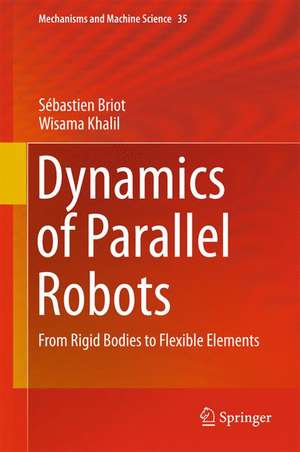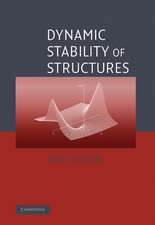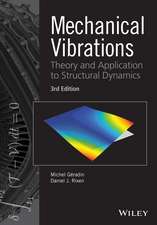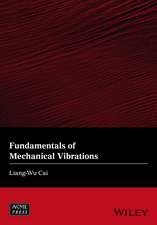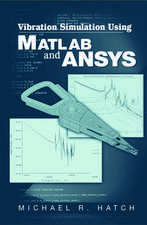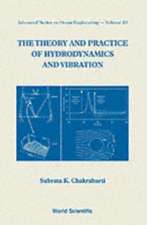Dynamics of Parallel Robots: From Rigid Bodies to Flexible Elements: Mechanisms and Machine Science, cartea 35
Autor Sébastien Briot, Wisama Khalilen Limba Engleză Hardback – iul 2015
| Toate formatele și edițiile | Preț | Express |
|---|---|---|
| Paperback (1) | 644.18 lei 6-8 săpt. | |
| Springer International Publishing – 15 oct 2016 | 644.18 lei 6-8 săpt. | |
| Hardback (1) | 650.37 lei 6-8 săpt. | |
| Springer International Publishing – iul 2015 | 650.37 lei 6-8 săpt. |
Din seria Mechanisms and Machine Science
- 20%
 Preț: 817.44 lei
Preț: 817.44 lei - 17%
 Preț: 364.75 lei
Preț: 364.75 lei - 20%
 Preț: 1001.90 lei
Preț: 1001.90 lei - 18%
 Preț: 1268.55 lei
Preț: 1268.55 lei - 18%
 Preț: 945.79 lei
Preț: 945.79 lei - 18%
 Preț: 1275.65 lei
Preț: 1275.65 lei - 18%
 Preț: 1392.46 lei
Preț: 1392.46 lei - 18%
 Preț: 1386.17 lei
Preț: 1386.17 lei - 18%
 Preț: 2142.21 lei
Preț: 2142.21 lei - 18%
 Preț: 1382.21 lei
Preț: 1382.21 lei - 15%
 Preț: 604.87 lei
Preț: 604.87 lei - 18%
 Preț: 1104.43 lei
Preț: 1104.43 lei - 18%
 Preț: 2768.05 lei
Preț: 2768.05 lei - 18%
 Preț: 1625.27 lei
Preț: 1625.27 lei - 18%
 Preț: 1872.30 lei
Preț: 1872.30 lei - 18%
 Preț: 899.21 lei
Preț: 899.21 lei - 18%
 Preț: 1550.30 lei
Preț: 1550.30 lei - 18%
 Preț: 1832.85 lei
Preț: 1832.85 lei - 18%
 Preț: 1572.40 lei
Preț: 1572.40 lei - 18%
 Preț: 1549.54 lei
Preț: 1549.54 lei - 15%
 Preț: 649.87 lei
Preț: 649.87 lei - 18%
 Preț: 950.52 lei
Preț: 950.52 lei - 18%
 Preț: 953.97 lei
Preț: 953.97 lei - 18%
 Preț: 959.19 lei
Preț: 959.19 lei - 18%
 Preț: 1217.10 lei
Preț: 1217.10 lei - 18%
 Preț: 1387.73 lei
Preț: 1387.73 lei - 18%
 Preț: 1218.21 lei
Preț: 1218.21 lei - 18%
 Preț: 1546.05 lei
Preț: 1546.05 lei - 18%
 Preț: 1550.30 lei
Preț: 1550.30 lei - 18%
 Preț: 1846.73 lei
Preț: 1846.73 lei - 18%
 Preț: 1538.34 lei
Preț: 1538.34 lei - 18%
 Preț: 1000.24 lei
Preț: 1000.24 lei - 18%
 Preț: 1397.82 lei
Preț: 1397.82 lei -
 Preț: 448.88 lei
Preț: 448.88 lei - 18%
 Preț: 1233.52 lei
Preț: 1233.52 lei
Preț: 650.37 lei
Preț vechi: 765.14 lei
-15% Nou
Puncte Express: 976
Preț estimativ în valută:
124.45€ • 135.60$ • 104.87£
124.45€ • 135.60$ • 104.87£
Carte tipărită la comandă
Livrare economică 23 aprilie-07 mai
Preluare comenzi: 021 569.72.76
Specificații
ISBN-13: 9783319197876
ISBN-10: 3319197878
Pagini: 300
Ilustrații: XVII, 350 p. 119 illus.
Dimensiuni: 155 x 235 x 25 mm
Greutate: 0.69 kg
Ediția:2015
Editura: Springer International Publishing
Colecția Springer
Seria Mechanisms and Machine Science
Locul publicării:Cham, Switzerland
ISBN-10: 3319197878
Pagini: 300
Ilustrații: XVII, 350 p. 119 illus.
Dimensiuni: 155 x 235 x 25 mm
Greutate: 0.69 kg
Ediția:2015
Editura: Springer International Publishing
Colecția Springer
Seria Mechanisms and Machine Science
Locul publicării:Cham, Switzerland
Public țintă
ResearchCuprins
Part I Prerequisites.- 1 Generalities on parallel robots.- 1.1 Introduction.- 1.2 General definitions.- 1.3 Types of PKM architectures.- 1.4 Why a book dedicated to the dynamics of parallel robots?.- 2 Homogeneous transformation matrix.- 2.1 Homogeneous coordinates and homogeneous transformation matrix.- 2.2 Elementary transformation matrices.- 2.3 Properties of homogeneous transformation matrices.- 2.4 Parameterization of the general matrices of rotation.- 3 Representation of velocities and forces / acceleration of a body.- 3.1 Definition of a screw.- 3.2 Kinematic screw (or twist).- 3.3 Representation of forces and moments (wrench).- 3.4 Condition of reciprocity.- 3.5 Transformation matrix between twists.- 3.6 Transformation matrix between wrenches.- 3.7 Acceleration of a body.- 4 Kinematic parameterizing of multibody systems.- 4.1 Kinematic pairs and joint variables.- 4.2 Modified Denavit-Hartenberg parameters.- 5 Geometric, velocity and acceleration analysis of open kinematic chains.- 5.1 Geometric analysis of open kinematic chains.- 5.2 Velocity analysis of open kinematic chains.- 5.3 Acceleration analysis of open kinematic chains.- 6 Dynamics principles.- 6.1 The Lagrange formulation.- 6.2 The Newton-Euler equations.- 6.3 The principle of virtual powers.- 6.4 Computation of actuator input efforts under a wrench exerted on the end-effector.- Part II Dynamics of rigid parallel robots.- 7 Kinematics of parallel robots.- 7.1 Inverse geometric model.- 7.2 Forward geometric model.- 7.3 Velocity analysis.- 7.4 Acceleration analysis.- 7.5 Singularity analysis.- 8 Dynamic modeling of parallel robots.- 8.1 Introduction.- 8.2 Dynamics of tree-structure robots.- 8.3 Dynamic model of the free moving platform.- 8.4 Inverse and direct dynamic models of non-redundant parallel robots.- 8.5 Inverse and direct dynamic models of parallel robots with actuation redundancy.- 8.6 Other models.- 8.7 Computation of the base dynamic parameters.- 9 Analysis of the degeneracy conditions for the dynamic model of parallel robots.- 9.1 Introduction.- 9.2 Analysis of the degeneracy conditions of the IDM of PKM.- 9.3 Avoiding infinite input efforts while crossing Type 2 or LPJTS singularities thanks to an optimal trajectory planning.- 9.4 Example 1: the five-bar mechanism crossing a Type 2 singularity.- 9.5 Example 2: the Tripterion crossing a LPJTS singularity.- 9.6 Discussion.- Part III Dynamics of flexible parallel robots.- 10 Elastodynamic modeling of parallel robots.- 10.1 Introduction.- 10.2 Generalized Newton-Euler equations of a flexible link.- 10.2.3 Matrix form of the generalized Newton-Euler model for a flexible clamped-free body.- 10.3 Dynamic model of virtual flexible systems.- 10.4 Dynamic model of a flexible parallel robot.- 10.5 Including the actuator elasticity.- 10.6 Practical implementation of the algorithm.- 10.7 Case Study: the DualEMPS.- 11 Computation of natural frequencies.- 11.1 Introduction.- 11.2 Stiffness and inertia matrices of the virtual system.- 11.3 Stiffness and inertia matrices of the PKM.- 11.4 Including the actuator elasticity.- 11.5 Practical implementation of the algorithm.- 11.6 Case Studies.- 11.7 Conclusion.- Appendices.- A Calculation of the number of degrees of freedom of robots with closed chains.- A.1 Introduction.- A.2 Moroskine’s Method.- A.3 Gogu’s Method.- A.4 Examples.- B Lagrange equations with multipliers.- C Computation of wrenches reciprocal to a system of twists.- C.1 Definitions.- C.2 Condition of reciprocity.- C.3 Computation of wrenches reciprocal to a system of twists constrained in a plane.- C.4 Computation of wrenches reciprocal to other types of twist systems.- D Point-to-point trajectory generation.- E Calculation of the terms facc1 , facc2 and facc3 in Chapter 10.- E.1 Calculation of the term facc1.- E.2 Calculation of the term facc2.- E.3 Calculation of the term facc3.- F Dynamics equations for a clamped-free flexible beam.- F.1 Shape functions for a free flexible beam.- F.2 Stiffness matrix for a free flexible beam.- F.3 Evaluation of the inertia matrix of a free flexible 3D Bernoulli beam for qe j = 0.- References.- Index.
Recenzii
“The present book, based on results published by many authors as well as by the two authors of the book over the last fifteen years, treats some special problems on the dynamics of parallel robots from rigid bodies to flexible elements … . the intended audience for it consists of researchers, scientists and engineers, as well as master and PhD students interested in the theory and applications of parallel robots.” (Clementina Mladenova, zbMATH 1369.68001, 2017)
Textul de pe ultima copertă
This book starts with a short recapitulation on basic concepts, common to any types of robots (serial, tree structure, parallel, etc.), that are also necessary for computation of the dynamic models of parallel robots. Then, as dynamics requires the use of geometry and kinematics, the general equations of geometric and kinematic models of parallel robots are given. After, it is explained that parallel robot dynamic models can be obtained by decomposing the real robot into two virtual systems: a tree-structure robot (equivalent to the robot legs for which all joints would be actuated) plus a free body corresponding to the platform. Thus, the dynamics of rigid tree-structure robots is analyzed and algorithms to obtain their dynamic models in the most compact form are given. The dynamic model of the real rigid parallel robot is obtained by closing the loops through the use of the Lagrange multipliers. The problem of the dynamic model degeneracy near singularities is treated and optimaltrajectory planning for crossing singularities is proposed. Lastly, the approach is extended to flexible parallel robots and the algorithms for computing their symbolic model in the most compact form are given. All theoretical developments are validated through experiments.
Caracteristici
Fully dedicated to the dynamics of parallel robots (rigid and flexible) Includes mathematica codes for the computation of dynamic models of rigid and flexible parallel robots Includes experimental results that show that dynamic models are not only equations, but are strongly linked to reality Includes supplementary material: sn.pub/extras
